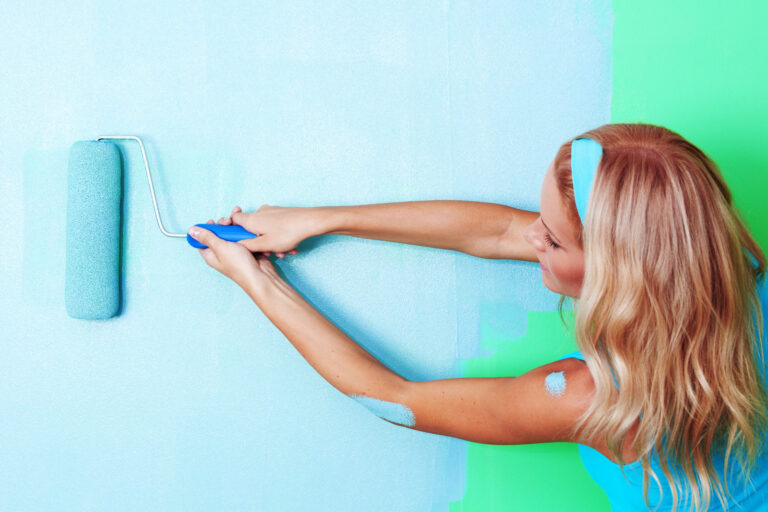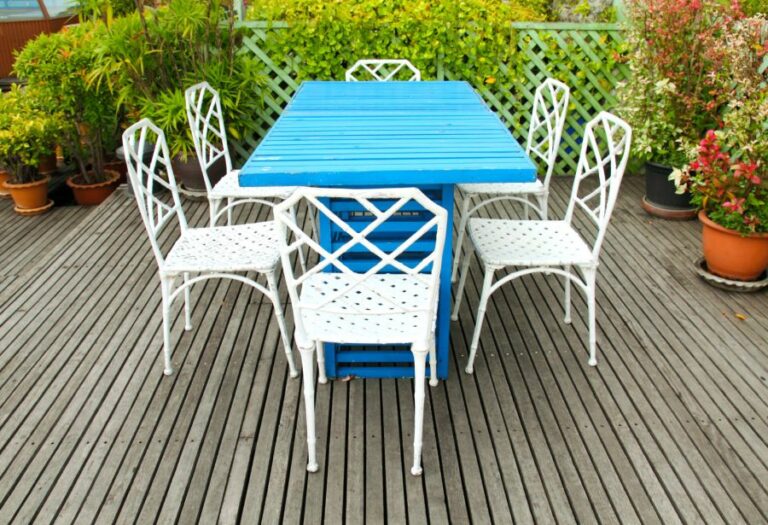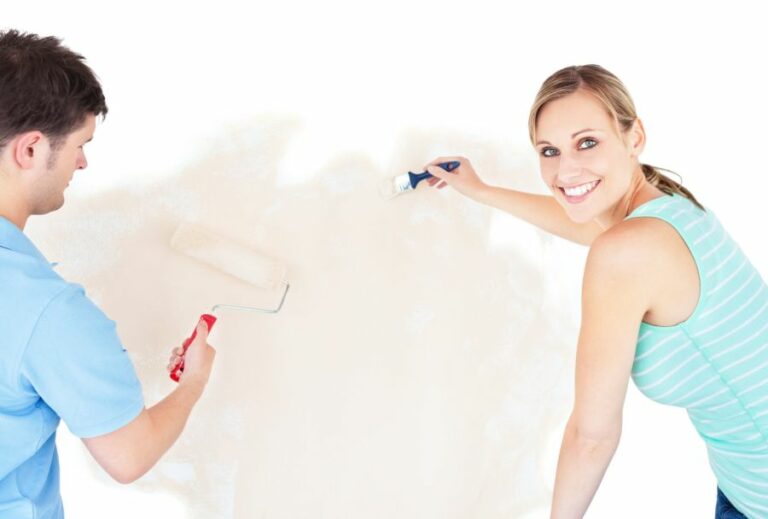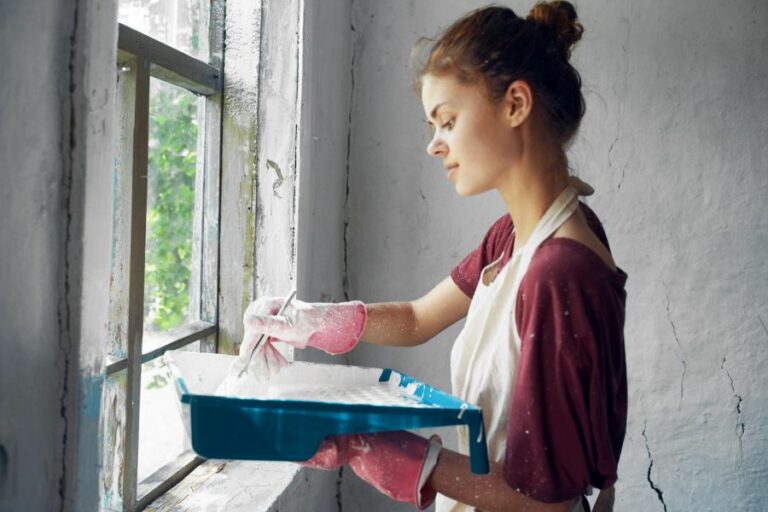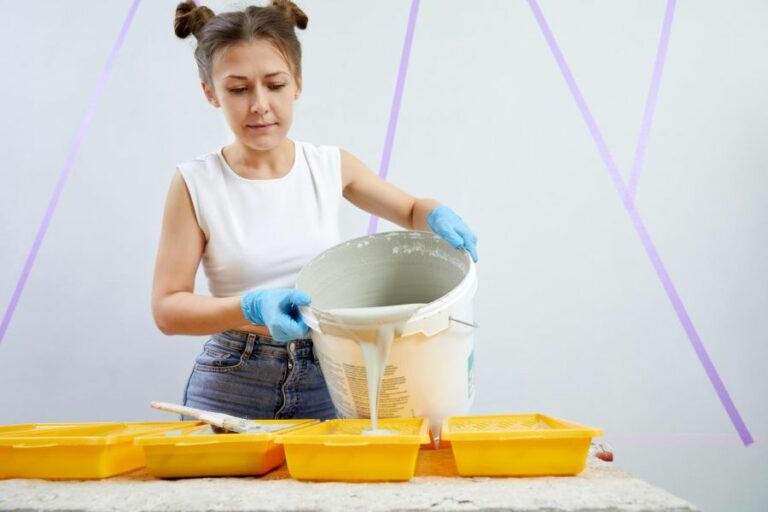Outdoor Gold Paint, 25 Things You Should Know
Are you looking to infuse some glamour and elegance into your outdoor furniture or decor? Look no further because outdoor gold paint is the perfect solution to transform your space with a touch of luxury. With years of experience in the painting industry and a wealth of knowledge on this fabulous paint, I’m here to provide you with the confidence to make informed decisions and help you achieve stunning results.
Outdoor gold paint:
Outdoor gold paint is a versatile and visually striking option for various outdoor projects, available in acrylic, oil-based, and spray forms. To achieve a perfect gold finish, choose the appropriate paint type, prepare the surface, apply primer, use multiple coats, and protect the finish with a clear sealer. Maintain the gold-painted items by cleaning gently, inspecting and touching them up, and protecting them from extreme weather conditions.
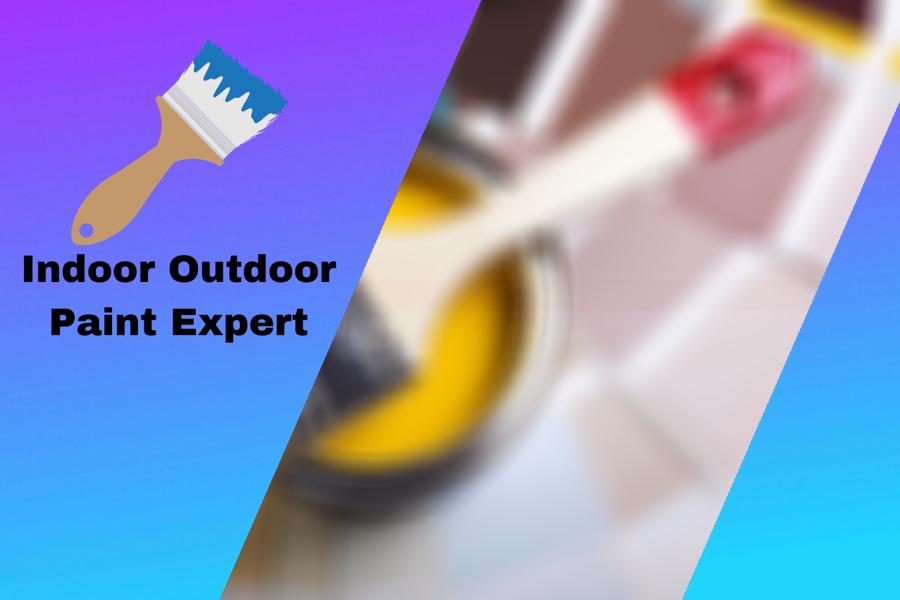
Ready to create a dazzling, golden landscape? Discover the secrets of using outdoor gold paint for your next project. Read on for tips, tricks, and innovative ideas to transform your space into a luxurious haven. Don’t miss out!
Contents
- 1 Exterior Gold Paint for Professional Use
- 2 What is the Most Effective and Durable Gold Paint for Outdoor Applications?
- 3 Is it Possible to Utilize Metallic Paint for Exterior Applications?
- 4 Which Type of Paint is Most Suitable for Exterior Applications?
- 5 Does the Color of Gold Paint Experience Fading Due to Sun Exposure?
Exterior Gold Paint for Professional Use
Gold paint is a versatile and visually striking option for a variety of outdoor projects. Whether you’re looking for a statement piece for your garden or a bold way to update your outdoor furniture, outdoor gold paint is an excellent choice.
• Types of Outdoor Gold Paint
There are several types of gold paint available on the market, each with its own unique characteristics and best uses.
– Acrylic Gold Paint
Acrylic gold paint is water-based, which makes it easy to clean up with soap and water. It is quick-drying and is suitable for use on metal, plastic, paper, and wood.
Higher-quality acrylic gold paint will give you more vibrant and metallic results, but the lower-quality ones can often end up appearing dull and somewhat flat. Look for products labeled “metallic gold” and “acrylic-based paint” for the best results.
– Oil-Based Gold Paint
Oil-based gold paint is used primarily for metal and wood surfaces. It is more durable than acrylic gold paint, but it takes longer to dry, often up to 24 hours. Oil-based gold paint will give you a more reflective, high-gloss finish and is a better choice for outdoor items that will be exposed to the elements.
– Spray Gold Paint
Spray gold paint is available in both acrylic and oil-based formulas and is ideal for larger projects or items with hard-to-reach areas. The aerosol application allows for more even coverage and is also quicker to apply than painting with a brush.
• Achieving the Perfect Gold Finish – Expert Tips
Now that you know the types of gold paint available, let’s talk about how to achieve the perfect outdoor gold finish.
1. Choose the right paint
Be sure to choose the appropriate type of gold paint for your needs, considering factors such as the material you will be painting on, the amount of exposure to the elements, and your desired finish.
2. Prep your surface
Proper surface preparation is crucial to achieving a successful gold finish. Clean the area thoroughly, removing dirt, dust, and any loose paint. For metal surfaces, a light sanding with fine-grit sandpaper can help to create a more adhesive surface.
3. Prime your surface
Using a primer before painting is essential for the longevity and durability of your gold finish. It helps to create a stable base for your gold paint and improves adhesion.
Choose a high-quality outdoor primer that is appropriate for the material of your item and follow the manufacturer’s instructions for application.
4. Apply multiple coats
Achieving a stunning gold finish often requires multiple coats of paint. Between coats, allow the paint to dry completely for at least 2-3 hours.
The exact number of coats required will vary depending on the paint you are using and the surface you are painting, so consult the manufacturer’s recommendations and test on a small, inconspicuous area first.
5. Protect your finish
For added durability, consider applying a clear sealer over your gold finish once it has cured. This protective layer helps to prevent chipping and fading, keeping your gold paint looking fresh and bright.
• Maintaining Your Outdoor Gold Paint
Proper maintenance is key to preserving the appearance and integrity of your outdoor gold paint. Follow these tips to keep your gold-painted items looking their best:
- Clean gently: Avoid using harsh chemicals or abrasive materials that can damage the gold finish. Instead, use warm water mixed with mild soap for regular cleaning.
- Inspect and touch up: Periodically inspect your gold-painted items for signs of chipping, fading, or other damage. Touch up any areas that need it with the appropriate gold paint.
- Protect from the elements: To prolong the life of your gold finish, consider moving your gold-painted items to sheltered locations during extreme weather conditions.
Outdoor gold paint can be an excellent way to transform ordinary outdoor items into eye-catching, creative pieces.
By understanding the types of gold paint available, taking care to properly prepare and paint your surface, and maintaining your finished project, you can enjoy your gleaming, gold-painted outdoor items for years to come.
What is the Most Effective and Durable Gold Paint for Outdoor Applications?
When it comes to outdoor decorations and fixtures, choosing the right gold paint can make all the difference. The perfect gold paint will not only enhance the appearance of your objects but also offer protection against the challenges posed by weather conditions.
To help you make an informed decision, let’s explore the different types of gold paint available and their features, followed by recommendations on the best gold paints for outdoor use.
• Types of Gold Paints and Their Features
1. Oil-Based Paints
Oil-based gold paints are known for their durability and resistance to harsh environmental conditions. They can offer long-lasting protection to the surfaces they are applied on, thanks to their ability to penetrate deeply into the substrate.
The main disadvantages of oil-based paints are that they require more time to cure and are prone to yellowing over time.
2. Acrylic or Water-Based Paints
Acrylic or water-based gold paints are easier to clean up and dry more quickly than their oil-based counterparts. They are typically low in VOCs (volatile organic compounds) and have a lower odor, making them a more environmentally friendly option.
However, these paints might not be as long-lasting or resistant to outdoor conditions as oil-based paints.
3. Spray Paints
Gold spray paints can be oil-based or acrylic-based and provide a convenient way to paint intricate or difficult-to-reach surfaces. They require minimal preparation and can be easily applied.
While the versatility of spray paints makes them a popular option, they might not offer the same level of durability as traditional brush-on paints.
4. Metallic Paints
Metallic gold paints contain tiny, reflective particles that give them a shiny, metallic appearance. These paints are available in oil-based, acrylic, and spray varieties.
Although metallic gold paints can provide a stunning, lustrous appearance, they may not be as durable or resistant to fading as some other types of gold paint.
5. Gold Leaf
Gold leaf is an alternative to gold paint made from thin, delicate sheets of gold. While gold leaf can provide the most authentic and striking gold finish, it is not suitable for all outdoor applications. Moreover, gold leaf requires a high level of skill and expertise to apply correctly.
• Criteria to Consider When Choosing Gold Paint for Outdoor Use
To select the best gold paint for your outdoor project, consider the following factors:
1. Durability and Weather Resistance
The paint should be able to withstand harsh weather conditions, such as direct sunlight, rain, snow, and temperature fluctuations. Oil-based paints are generally more durable and resistant to the elements than acrylic-based paints and may be the better choice for outdoor use.
2. UV Resistance
Repeated exposure to UV rays from the sun can cause gold paint to fade or lose its luster over time. Look for gold paint products specifically designed for outdoor use, as they have added UV inhibitors that prolong their color and durability in sunlight.
3. Coverage and Application
Choose a gold paint that provides good coverage and is easy to apply. Spray paints are user-friendly and allow for an even coating on intricate or difficult-to-reach surfaces. However, brush-on paints may offer greater durability and are well-suited for larger projects.
4. Finish
Consider whether you want a matte, satin, or glossy finish for your outdoor project. Typically, glossy finishes are better suited for outdoor use due to their ability to reflect light, which can help protect the paint from UV damage.
5. Drying Time and Cleanup
If you need a quick-drying option, consider acrylic or water-based paints, as they dry faster compared to oil-based paints. Acrylic paints are also easier to clean up, requiring only water and soap.
• Recommendations for the Best Gold Paints for Outdoor Use
Based on the criteria mentioned above, the following paints provide reliable options for outdoor use:
1. Rust-Oleum Stops Rust Metallic Spray Paint
This oil-based spray paint offers excellent weather resistance, durability, and UV protection. It dries quickly and works well on a variety of surfaces, including wood, metal, and plastic.
The metallic finish provides an attractive sheen that makes it an excellent choice for outdoor decorative projects. The product can be found here for more information.
2. Modern Masters Exterior/Interior Metallic Paint
Modern Masters offers a water-based, acrylic gold paint that combines the benefits of easy application and clean-up with the durability necessary for outdoor use. The UV-resistant formula ensures long-lasting color, while the metallic finish provides an attractive shine.
This paint is suitable for use on wood, metal, and other outdoor surfaces. Check out the Modern Masters website for more details on this product.
3. Krylon Premium Metallic Spray Paint
Krylon’s metallic spray paint is suitable for outdoor use, offering a durable and long-lasting finish. The paint dries quickly and provides good coverage on various surfaces, including wood, metal, and plastic.
The gold color remains vibrant and resistant to fading, making it a reliable option for outdoor applications. Refer to the Krylon website for further information on this paint.
• Conclusion
In summary, your choice of gold paint for outdoor use will depend on your specific requirements and preferences. Look for products that offer durability, weather resistance, UV protection, and an attractive finish to create long-lasting and visually appealing outdoor projects.
The Rust-Oleum Stops Rust Metallic Spray Paint, Modern Masters Exterior/Interior Metallic Paint, and Krylon Premium Metallic Spray Paint are three recommended options that meet these criteria.
Is it Possible to Utilize Metallic Paint for Exterior Applications?
• Understanding Metallic Paint
Before delving into the main topic, it’s essential to understand what metallic paint is and why it’s a popular choice for both interior and exterior applications. Metallic paint is a type of decorative paint that contains metal flakes or powdered metal, resulting in a shimmering, reflective finish.
It adds depth, texture, and visual interest to any surface, making it a popular choice for various applications, including automotive, furniture, and home improvement projects.
• Advantages of Using Metallic Paint Outdoors
There are several reasons why metallic paints can be beneficial for outdoor surfaces, which include:
– Aesthetic Appeal
Metallic paints offer a unique, eye-catching appearance that can enhance the visual appeal of your home or other outside structures. The light-reflective properties of these paints add depth and dimension to any surface, making it stand out from the crowd.
– Durability
The metal particles in metallic paint can create a durable, long-lasting finish capable of withstanding the elements, such as UV rays, humidity, and temperature changes.
Additionally, metallic paint often possesses excellent adhesion qualities, allowing it to adhere well to various surfaces without peeling or chipping.
– Versatility
Metallic paints can be applied to a wide range of surfaces, including wood, metal, and masonry. This versatility, combined with the numerous color and finish options available, means that metallic paint can be used for almost any outdoor project imaginable.
• Factors to Consider When Choosing Metallic Paint for Outdoor Use
Not all metallic paints may be suitable for use on outdoor surfaces; thus, it’s essential to consider the following factors to ensure the best results:
– Surface Preparation
Just like with any other exterior painting project, proper surface preparation is crucial to ensure that the metallic paint adheres well and lasts as long as possible. This generally involves cleaning the surface, removing loose or peeling paint, sanding, and applying a suitable primer.
Some metallic paints may require a specific primer or undercoat for optimal adhesion, so make sure to read and follow the manufacturer’s recommendations.
– Application Techniques
The application technique can significantly impact the final appearance of metallic paint. Using the wrong technique or tools could result in streaks, uneven color distribution, or a lack of the desired metallic effect.
It’s essential to educate yourself on the correct application method for your chosen metallic paint and gather the necessary tools before starting your project.
For most metallic paints, I recommend using a high-quality synthetic brush or a paint sprayer to achieve an even, smooth finish.
– Finish and Protective Coating
The finish of the metallic paint can also play a role in its suitability for outdoor use. Some metallic paints may have a glossy or semi-gloss finish that may require an additional protective clear coat to enhance their durability and protection against the elements.
On the other hand, some metallic paints are formulated with a built-in sealant or protective layer, making them even more suitable for outdoor applications.
Always check the manufacturer’s recommendations regarding protective coatings and ensure that the chosen clear coat is compatible with the metallic paint.
• Common Outdoor Metallic Paint Applications
Here are some popular applications of metallic paint for outdoor use:
– Exterior Walls
Adding a touch of metallic paint to exterior walls can create a dramatic and sophisticated appearance. Keep in mind that using metallic paint on large surfaces may require more effort and time, but the stunning results are often worth the extra effort.
– Doors
Applying metallic paint to your front door can create a welcoming and stylish entrance to your home. Be sure to select a suitable paint that can withstand the wear and tear of everyday use.
– Garden Furniture
Adding a splash of metallic paint to your outdoor furniture can refresh and update its appearance, contributing to a more polished and cohesive garden design.
– Metalwork
Using metallic paint on railings, fences, or garden ornaments can add a touch of elegance and refinement to your outdoor space.
• Conclusion
In conclusion, using metallic paint outdoors can be a rewarding and visually striking addition to your exterior surfaces, provided you choose the appropriate paint and follow the correct application methods.
By carefully considering your specific project’s needs and the factors listed in this article, you can achieve a long-lasting, stunning metallic finish that enhances your home’s curb appeal and adds a touch of uniqueness to your outdoor spaces.
| Can you use metallic paint outside? | |
|---|---|
| Pros | – Unique and attractive appearance – Durable and long-lasting when proper steps are taken – Resistant to corrosion and weathering – Available in a wide range of colors and styles |
| Cons | – Requires proper surface preparation and priming for the best results – May require more maintenance and recoating compared to other types of exterior paint – Can be more expensive than traditional exterior paints – Susceptible to fading and damage from direct sunlight/UV exposure |
Which Type of Paint is Most Suitable for Exterior Applications?
Painting the exterior of your home or building is an important task that requires thoughtful consideration. After all, the paint you choose directly impacts not only the look and feel of the space but also its durability and longevity.
• Understanding Exterior Paint Types
There are two main types of exterior paint: water-based (or latex) and oil-based (or alkyd) paints. Each type has its own set of advantages and disadvantages, which we’ll explore below.
– Water-Based Latex Paint
Water-based latex paint is one of the most popular choices for exterior surfaces due to its durability, ease of application, and quick drying time. Latex paints are made from a combination of water, pigments, and acrylic or vinyl binders.
Pros:
- Easy to clean up with soap and water
- Expands and contracts with changing weather conditions, reducing the likelihood of cracking – Quick drying time (usually within a few hours)
- Low levels of volatile organic compounds (VOCs), which leads to less odor and a more environmentally friendly paint
Cons:
- Can be sensitive to temperature changes during application
- May not adhere as well to certain surfaces, such as metal or chalky surfaces
– Oil-Based Alkyd Paint
Oil-based alkyd paint is an older choice for exterior painting and has been largely replaced by water-based latex paint. Alkyd paints are made from a mixture of oil (usually linseed or soybean oil), pigments, and alkyd resins.
Pros:
- Excellent adhesion to a variety of surfaces
- Durable and long-lasting
- Better flow and leveling, providing a smooth finish
Cons:
- Longer drying time (usually 24 hours or more)
- High levels of VOCs, contributing to strong odors and potential environmental concerns
- More difficult to clean up, requiring paint thinner or mineral spirits
• Picking the Right Exterior Paint Sheen
The sheen or finish of the paint also plays a critical role in determining the paint’s durability, ease of application, and overall aesthetic appeal. The most common sheens for exterior paint are flat/matte, satin, semi-gloss, and gloss.
– Flat/Matte Sheen
Flat or matte paint has the least amount of gloss, providing a smooth and non-reflective finish. This type of sheen is ideal for concealing imperfections on exterior surfaces, making it a popular choice for older homes.
Recommended for:
- Siding
- Stucco
- Brick
- Concrete
– Satin Sheen
Satin paint provides a slight sheen, giving it a soft, pearl-like appearance. This sheen offers more dirt resistance than flat paint while still maintaining a relatively low level of shine.
Recommended for:
- Wood siding
- Doors and windows
- Trim
– Semi-Gloss Sheen
Semi-gloss paint has a higher sheen level than satin paint, providing a slightly glossy appearance. This sheen is more durable and easier to clean, making it an ideal choice for areas exposed to more wear and tear.
Recommended for:
- Doors and windows
- Trim
- Gutters and downspouts
- Railings
– Gloss Sheen
Gloss paint offers the highest level of sheen, creating a shiny and reflective surface. This type of sheen is extremely durable and easy to clean but may draw more attention to surface imperfections.
Recommended for:
- Doors and windows
- Trim
- Railings
- Wrought iron
• Additional Factors to Consider
Besides the type of paint and the sheen, you should also consider the following factors when choosing the best paint for your exterior surfaces:
- Durability: Look for paints with a history of longevity, particularly in extreme weather conditions. High-quality paints are more likely to withstand fluctuating temperatures, moisture, and UV exposure.
- Primer: Depending on the surface and existing paint, a high-quality primer may be necessary before applying the new paint. This will ensure better adhesion and longer-lasting results.
- Color: The color you choose plays a significant role in the overall appearance and curb appeal of your home or building. Consider the surrounding environment, architectural style, and personal preferences when choosing the ideal color.
For helpful tips on choosing the best exterior paint color, explore HGTV’s gallery of exterior house colors.
• Conclusion
In conclusion, the best paint for exterior surfaces is water-based latex paint with the appropriate sheen, taking into consideration the specific surface material and the desired appearance.
Factors such as durability, primer, and color also play a critical role in making the best choice for your exterior painting project. Following these guidelines will help ensure that your home or building has a beautiful and long-lasting paint job that enhances its curb appeal and overall value.
Type of paint | Advantages | Disadvantages |
|---|---|---|
Acrylic Latex | Water-based, easy to clean, dries quickly, durable, resistant to UV rays and weathering | May not adhere well to certain surfaces, requires proper surface preparation |
Oil-based | Excellent adhesion, durable and long-lasting, smooth finish | Slow drying time, harder to clean, may become brittle and crack over time, not environmentally friendly |
Alkyd | Good adhesion, resists chalking and fading, good flow and leveling | Requires solvents for cleanup, not environmentally friendly, slow drying time |
Enamel | Hard, durable finish, impact and abrasion-resistant, withstands harsh weather conditions | May require multiple coats, requires proper surface preparation, longer drying time |
Does the Color of Gold Paint Experience Fading Due to Sun Exposure?
• Introduction
Gold paint is a popular choice for various applications and surfaces, from walls to artwork, crafts, and even automotive detailing. Being a metallic paint, its lustrous and reflective properties make it unique and aesthetically appealing.
However, one concern that arises while choosing gold paint is whether or not it fades when exposed to sunlight over a long period.
Questions about the reasons for possible fading, how to avoid it, and choosing the right gold paint to combat fading become crucial to ensure the durability and longevity of the desired finish.
• Factors Affecting Gold Paint Fading
– UV Exposure
Sunlight has a significant impact on the rate at which gold paint fades. Ultraviolet (UV) rays in sunlight cause pigments in the paint to break down over time, which leads to fading.
Some gold paints are more resistant to UV radiation than others, making them better suited for outdoor or sunny indoor applications.
– Type of Gold Paint
Gold paint comes in various formulations and types, with each having its distinct characteristics in terms of resistance to fading. For example, gold paints with high-quality pigments generally have better resistance to fading than lower-quality paints. Some of the common types of gold paints are:
- Acrylic
- Alkyd
- Oil-based
- Water-based
- Spray cans
Each of these types responds differently to sunlight exposure, leading to varied levels of fading. It is essential to choose the right type of gold paint with resistance to sunlight for your specific application and environment.
– Surface Material and Preparation
The surface on which the gold paint is applied also influences its resistance to fading. Porous materials, like wood or untreated plaster, can lead to faster fading as they absorb moisture and cause pigments to break down more quickly.
Moreover, improper surface preparation, like not priming or cleaning the surface, can lead to poor adhesion of paint, which will result in unexpected fading over time.
• How to Prevent Gold Paint Fading
– Use UV Resistant Gold Paint
One way to prevent gold paint from fading is by selecting a paint specifically formulated with resistance to UV light. High-quality acrylic, alkyd, or oil-based gold paints with UV protection can be a good choice for outdoor or sunny indoor applications.
Many paint manufacturers now offer UV-resistant gold paints designed for use in exterior and sun-exposed environments.
– Apply a Clear Sealer
Applying a clear sealer or topcoat that offers UV protection can significantly reduce the risk of gold paint fading. These sealers usually come in various finishes like matte, satin, and gloss, allowing you to achieve the desired sheen level for your project.
Ensure that the sealer you select is compatible with the gold paint you have used.
– Proper Surface Preparation
To ensure that the gold paint adheres well to the surface and maintains its color for a long time, prepare the surface correctly before applying the paint. This includes cleaning, priming, and sometimes sealing the surface to create a stable foundation for the paint.
Consult the manufacturer’s instructions and recommendations for preparing specific surfaces.
– Regular Maintenance
Regularly cleaning and maintaining the painted surface can help extend its life and prevent unwanted fading. Periodically inspect the surface for signs of wear and fading, and address potential issues before they become significant problems.
• Choosing the Right Gold Paint
When selecting gold paint, consider the following factors to ensure resistance to sunlight and avoid premature fading:
- Opt for a high-quality, UV-resistant paint specifically designed for outdoor or sunny indoor use.
- Choose the correct type of gold paint (acrylic, alkyd, oil-based, etc.) for your application and environment.
- Follow the manufacturer’s instructions and recommendations for surface preparation, application, and maintenance.
• Conclusion
While gold paint may fade in the sun, the impact of sunlight exposure can be minimized by choosing high-quality, UV-resistant paint and taking steps to protect and maintain the painted surface.
Selecting the right gold paint, using compatible sealers, and ensuring proper surface preparation and regular maintenance will help extend the life of the gold finish and maintain its lustrous appearance for a long time.
For more information on gold paint and how it responds to sunlight, you can visit The Smithsonian Institution’s Museum Conservation Institute for detailed insights on the topic.

